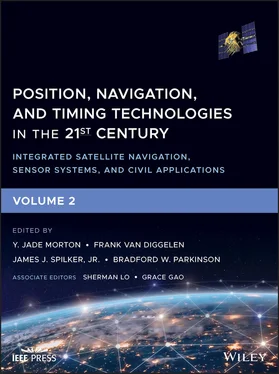RFID systems are commonly composed of one or more reading devices that can wirelessly obtain the ID of tags present in the environment. When the reader transmits an RF signal, RFID tags in the environment reflect the signal, modulating it by adding a unique identification code [15]. The tags can be active, that is, powered by a battery, or passive, drawing energy from the incoming radio signal. The detection range of passive tags is therefore more limited compared to that of active tags. RFID technology is used in a wide range of tracking applications in the automobile assembly industry, warehouse management systems, and across supply chain networks, where LOS contact is difficult or even impossible [16]. Passive RFID systems typically make use of four frequency bands: LF (125 kHz), HF (13.56 MHz), UHF (433, 868–915 MHz), and microwave frequency (2.45 GHz, 5.8 GHz). Active RFID systems use similar frequency ranges, except for the low‐frequency and high‐frequency ranges.
UWB radio technology is designed for short‐range, high‐bandwidth communication, with the desirable properties of strong multipath resistance. Unlike narrowband wireless technologies such as Wi‐Fi, which beam signals within a defined frequency band (e.g. the 2.4 GHz or 5 GHz band), UWB scatters its transmissions over several gigahertz of the spectrum (from 3.1 to 10.6 GHz in the United States as restricted by the FCC; 6.0 to 8.5 GHz in Europe as restricted by the ECC) using short pulses (typically <1 ns). UWB waves typically occupy a much larger frequency bandwidth (>500 MHz) than narrowband operation. Due to its spectrum‐scattered approach to communication, UWB is theoretically less susceptible to interference. UWB short‐duration pulses are easy to filter, to determine which signals are correct and which are generated from multipath. UWB signals also pass easily through walls, equipment, and clothing, but metallic and liquid materials can still cause UWB signal interference. A major advantage of using UWB for distance measurements is that large bandwidth translates into a higher resolution in time and consequently in distance than other technologies.
37.4.2.2 Broadcast and Wide Area Networks
Broadcast and wide area networks include networks designed for localization purposes, such as GPS, and broadcast networks not originally intended for localization purposes, such as television broadcast signals [17], cellular phone networks [18], and FM radio signals [19].
As the signal properties and geometrical arrangement of the digital TV broadcast network have been designed to penetrate indoors, they offer significantly greater indoor coverage than GPS‐based solutions. For instance, [17] proposed using synchronization signals already present in the Advanced Television Signal Committee (ATSC) standard for compliant digital TV signals to perform indoor localization. Emitters of digital television are synchronized with GPS time, allowing the data to be time‐stamped, which can be useful for distance estimation with ToA techniques ( Section 37.5.1.2). Digital TV signals also have a wide bandwidth of 5–8 MHz that can theoretically help reduce multipath mitigation. However, the weak density of terrestrial emitters causes the direct signal to arrive at low elevation angles near the horizon. As such, only 2D positioning is feasible, and multipath is severe because the direct signal is usually blocked.
Similar to digital TV networks, cellular networks have a wider range than, say, Wi‐Fi signals, and can also be used for indoor localization, much like with Wi‐Fi. With the Federal Communications Commission’s Enhanced‐911 (E‐911) mandate, cellular networks include positioning information as part of their standards. The E‐911 mandate requires mobile phones to be locatable within a 50 m accuracy for 67% of emergency calls. Such accuracies are usually achievable with the help of GPS signals. However, an accuracy of 50 m is insufficient for indoor areas. Therefore, cellular networks such as 2G/GSM, 3G UMTS, 4G LTE, and emerging standards must be utilized with other technologies for finer‐grained localization resolution in indoor environments.
FM radio is another possible candidate, utilizing frequency‐division multiple access (FDMA) to split the wireless band into a number of separate frequency channels that are used by stations. FM band ranges and channel separation distances vary in different regions, but the pervasiveness of FM signals can enable their use for indoor localization. Typically, radio waves operating in the frequency band 87.5 to 108.0 MHz are part of the FM spectrum. Due to the passive nature of the client devices, FM can be used in sensitive areas where other RF technologies are prohibited for safety or security reasons. Unfortunately, FM signals lack timing information, which limits their use in certain localization techniques (such as the time‐based trilateration techniques discussed in Section 37.5.1.2).
In general, the propagation of RF signals in indoor environments faces several challenges. Certain materials in the indoor environment affect the propagation of RF waves. For example, materials such as wood or concrete attenuate RF signals, while materials such as metals or water cause reflections, scattering, and diffraction of RF waves. These effects lead to multipath radio wave propagation, which prevents accurate calculation of the distance between the transmitter and the receiver in indoor environments. The propagation of RF waves is also affected by changes to the physical indoor environment (e.g. movement of people, rearrangement of furniture, structural modifications). In these environments, the RF properties are highly dynamic, and a radio map captured at a certain point in time cannot be used reliably for localization without accounting for these dynamic changes [12]. Moreover, while some solutions operate within a reserved radio band [18], most solutions utilize open spectrum bands. This means that these solutions must account for the increased risk of interference due to other systems sharing the same frequency bands of the radio spectrum. The usage of radio transmitting devices is also restricted in some cases, for example, in critical areas of most healthcare facilities, according to recommendations made by the Association for the Advancement of Medical Instrumentation (AAMI) [20] and other standards or regulatory bodies. Such restrictions limit the deployment of localization systems based on non‐broadcast RF waves.
Sonic waves are mechanical vibrations transmitted over a solid, liquid, or gaseous medium. The sonic waves produced by vibrations below and above the threshold of human hearing are known as infrasonic and ultrasonic waves, respectively. There are indoor localization solutions that propose the use of ultrasonic range finders and sonars [21]. The relative distance between two devices can be estimated from ToA measurements (see Section 37.5.1.2) of ultrasound pulses from the emitter to the receiver, and thus ultrasound signals can be used to estimate the position of the emitter tags from the receivers. Typical ultrasound systems operate in the low‐frequency band compared to the other RF signaling technologies. In contrast to RF waves, the ultrasound ToA operating range is 10 m or less due to the specific decay profile of the airborne acoustic channel. Doubling the distance causes the signal’s sound pressure level to attenuate by 6 dB due to radial intensity attenuation and absorption, which translates to an inverse quadratic attenuation in 3D space. In general, ultrasound signals are unable to penetrate walls, and they reflect off most indoor obstructions (furniture, people), resulting in echoes that can lead to localization inaccuracies. It has also been observed that high levels of ambient noise prevent accurate detection of the sonic signal; co‐interference caused by the presence of multiple sonic emitters in the environment also leads to errors. Variations in the speed of sound over air are another challenge: for instance, temperature variations are known to affect the speed of sound in air [22]. Therefore, sonic‐wave‐based systems cannot be used in environments with frequent and drastic temperature changes.
Читать дальше











